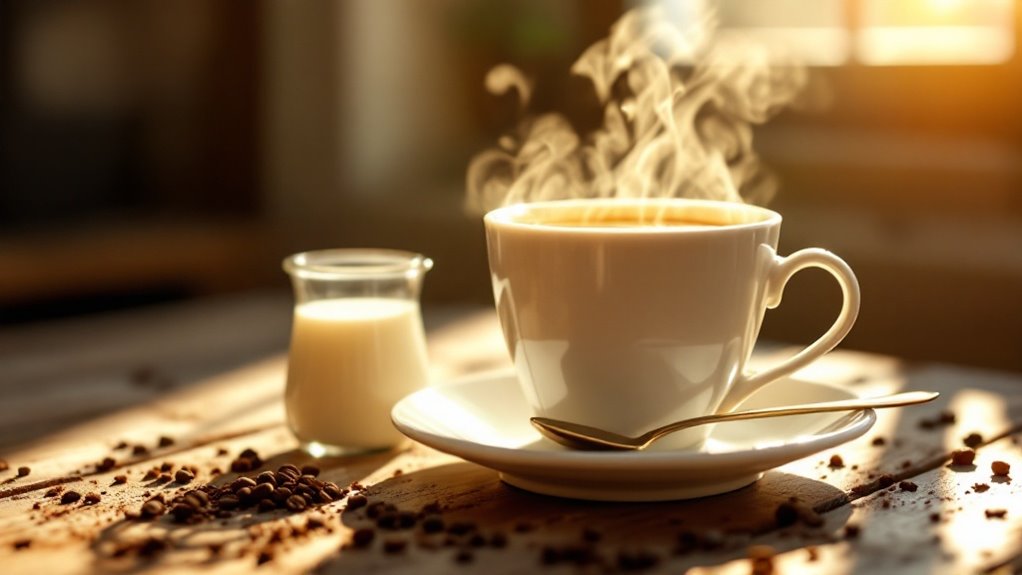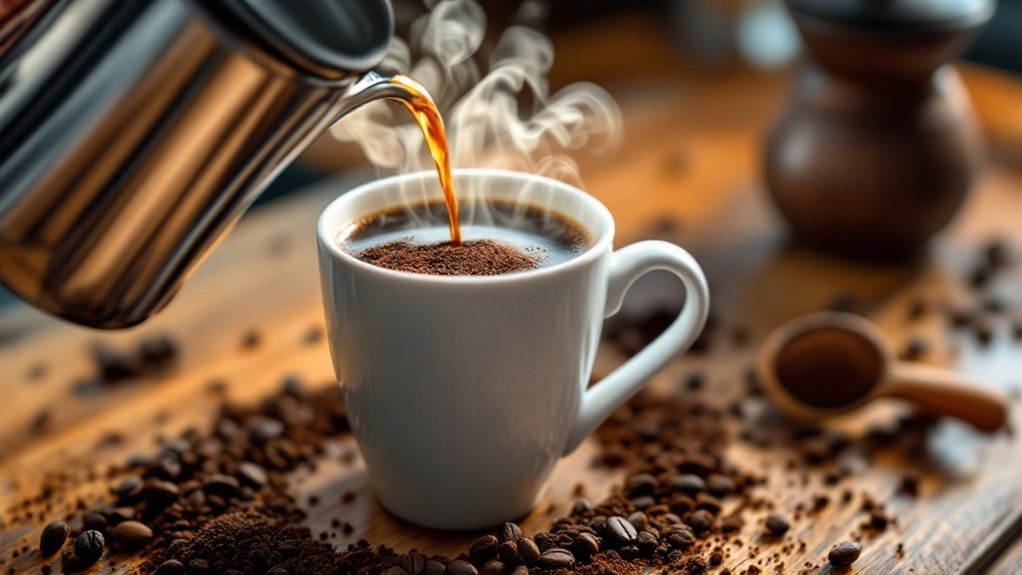







You might not realize that coffee filters aren't essential for brewing a great cup—improvised methods can yield surprisingly rich results. If you're out of filters, you can use everyday items like cheesecloth, a fine-mesh sieve, or even a clean sock to separate grounds from your brew. The key lies in controlling the steeping time and ensuring your makeshift filter doesn't alter the flavor. But how do you choose the right method for your taste, and what pitfalls should you avoid? The answers could transform your morning routine, even when you're unprepared.
Key Takeaways
- Use a fine-mesh sieve or reusable tea bag to strain coffee grounds after steeping in hot water for 4-6 minutes.
- Fold 2-3 layers of kitchen paper or paper towels into a cone shape as a makeshift filter over a cup or pour-over setup.
- Brew coffee directly in a pot by boiling water with grounds, then let it settle for 2 minutes before pouring carefully.
- Secure clean cheesecloth or a sock over a cup to filter coffee grounds, ensuring no residue or scents affect the taste.
- Use a French press or AeroPress Coffee Maker, which eliminates the need for disposable filters, for a rich, full-bodied brew.
Cold Brew Coffee Method
To make cold brew coffee, start by combining coarsely ground coffee with cold water in a large jar or pitcher. Use a 1:8 coffee-to-water ratio for a strong concentrate, guaranteeing you measure accurately to maintain quality. Stir the mixture gently to fully saturate the grounds, then cover the container tightly. Let it steep at room temperature or in the refrigerator for 12-24 hours, depending on your desired strength. The longer it steeps, the more concentrated and flavorful it becomes.
After steeping, strain the mixture to separate the liquid from the grounds. Use a fine-mesh strainer, cheesecloth, or a nut milk bag for clarity, pressing gently to extract all the liquid without forcing sediment through. This step secures a smooth, grit-free cold brew concentrate. Transfer the strained liquid into an airtight container and refrigerate it immediately. Properly stored, the concentrate will stay fresh for up to two weeks.
When serving, dilute the concentrate with water, milk, or ice to taste. Cold brew coffee's low acidity and naturally sweet flavor make it perfect for iced coffee, offering a revitalizing and mellow alternative to traditional brewing methods.
Turkish Coffee Technique
For a rich and aromatic cup of Turkish coffee, you'll need finely ground coffee, water, and optionally, sugar. Start by measuring 8 grams of finely ground coffee per cup and combine it with 60ml of water in a cezve or small saucepan. If you prefer sweetness, add 1 teaspoon of sugar per cup. Stir the mixture gently to make sure the coffee grounds are fully saturated.
Place the cezve on low heat and monitor it closely. As the mixture warms, a layer of foam will begin to form on the surface. Just before it reaches a boil, remove the cezve from the heat. Skim off the foam and discard it, then return the cezve to the heat. Repeat this process until the coffee boils.
Once boiled, let the coffee sit for 2 minutes to allow the grounds to settle. Pour the coffee slowly into cups, making sure the grounds remain at the bottom. Turkish coffee is traditionally served unfiltered, so the grounds will settle naturally. Enjoy the bold, full-bodied flavor of this time-honored brewing method.
Full Immersion Brewing
To steep coffee grounds without a filter, combine coarsely ground coffee with hot water in a 1:15 to 1:17 ratio and let it steep for 4 to 12 minutes, depending on your desired strength. After steeping, strain the mixture using a fine mesh sieve, cheesecloth, or even a clean kitchen towel to separate the grounds from the liquid. This method guarantees a full-bodied, rich coffee with minimal bitterness, as the grounds fully immerse and extract evenly.
Steeping Coffee Grounds
Steeping coffee grounds' simplicity makes it an excellent method for brewing without a filter. Start by measuring your coffee grounds and hot water using a 1:15 ratio—1 gram of coffee for every 15 grams of water. Use coarsely ground coffee to prevent over-extraction and reduce sediment. Heat your water to 195-205°F (90-96°C), making sure it's hot enough for ideal extraction but not boiling, which can scorch the grounds. Combine the coffee grounds and hot water in a heatproof container, stirring gently to make certain even saturation. Let the mixture steep for 4-6 minutes, depending on your desired strength. During this time, the coffee grounds release their flavors into the water, creating a full-bodied brew. Avoid over-steeping, as it can lead to bitterness. Once the steeping time is complete, you'll have a rich, flavorful coffee concentrate. This method, known as full immersion brewing, maximizes flavor extraction while minimizing bitterness, making it ideal for filter-free brewing. The next step involves straining the mixture to separate the grounds, but for now, focus on achieving the perfect steeping process to guarantee a high-quality cup.
Straining Without Filters
How can you strain coffee without a filter after full immersion brewing? Once your coffee grounds have steeped for 12-24 hours, you'll need to separate the liquid from the grounds using a fine mesh sieve, cheesecloth, or a combination of both. Start by placing a fine-mesh sieve over a large bowl or pitcher. Pour the coffee mixture through the sieve to catch the majority of the grounds. For a smoother result, line the sieve with a double layer of cheesecloth to trap finer particles. If you don't have a sieve, you can use cheesecloth alone by securing it over the mouth of your container with a rubber band and slowly pouring the coffee through. Gently press the grounds with a spoon to extract any remaining liquid, but avoid squeezing too hard to prevent bitterness. This method secures a clean, sediment-free concentrate. Whether you're making cold brew or heating the concentrate for hot coffee, straining with a fine mesh or cheesecloth assures a high-quality, low-acidity cup.
Faux-French Press Approach
If you don't have a French press but want a similar brewing method, the faux-French press approach is an effective alternative. Start by combining 16 grams of medium-ground coffee per cup with hot water (just off the boil) in a bowl or large mug. Stir the mixture thoroughly to guarantee even saturation of the coffee grounds, which is essential for extracting balanced flavors. Let the coffee steep for 2 minutes, allowing the grounds to settle naturally at the bottom. After steeping, press the grounds down gently with a spoon to separate them from the liquid, mimicking the plunger action of a French press. Finally, pour the brewed coffee slowly into your cup, using the spoon to hold back the grounds. This method produces a rich, full-bodied cup of coffee similar to French press coffee, with minimal sediment. For best results, use freshly ground coffee and water at the correct temperature to maximize flavor extraction. This technique is ideal for those seeking a French press-like experience without the specialized equipment.
Using Kitchen Paper in Machines
Fold a kitchen paper towel into a triangle and layer it three times to fit your coffee machine's filter basket, ensuring no grounds escape. Pre-wet the paper with hot water to eliminate residue and improve filtration quality. Insert the improvised filter, brew your coffee, and discard the used paper immediately to prevent clogging or buildup.
Paper Towel Filtration
Why not use a paper towel as a makeshift filter when you're out of coffee filters? A paper towel can serve as an effective coffee filter substitute in a pinch. Start by folding a plain white paper towel into a cone shape to fit your coffee maker's filter basket. Make sure it covers the entire area without gaps to prevent ground coffee from bypassing the filter. Use 2-3 layers of paper towel to create a sturdy barrier, reducing the risk of grounds passing through and clogging your machine. Before adding the coffee grounds, pre-wet the paper towel with hot water. This step removes any paper residue and helps the towel adhere properly to the basket. Once prepared, add your ground coffee to the lined basket and brew as usual. Keep an eye on the process to avoid overflow or clogging. After brewing, dispose of the used paper towel immediately to prevent it from clogging your sink or machine. This method guarantees a clean, quality brew even without traditional filters.
Machine Compatibility Tips
When using kitchen paper as a coffee filter substitute, make sure it's compatible with your machine to avoid damage or poor extraction. Start by folding the kitchen paper into a triangle and shaping it to fit the filter basket of your coffee maker. Confirm it covers the entire drip basket without overlapping the edges, as this can cause leaks or blockages. Use three layers of kitchen paper to prevent coffee grounds from passing through while maintaining proper water flow. Pre-wet the paper with hot water to remove any residue and help it adhere securely to the filter basket. Avoid bleached or scented kitchen paper, as these can alter the taste of your coffee. Monitor the brewing process closely, as kitchen paper may slow water flow compared to standard filters, potentially affecting extraction time. Adjust your coffee maker's settings if necessary to achieve the best possible results. By following these steps, you can guarantee your machine operates smoothly and produces a high-quality brew.
Household Items as Coffee Filters
If you don't have a coffee filter on hand, several household items can serve as effective substitutes. Start with paper towels, which are readily available and easy to use. Choose plain white towels to avoid introducing unwanted flavors. Fold the towel to fit your filter basket, making sure it's thick enough to prevent grounds from passing through. Pour hot water slowly to avoid tearing. For a reusable option, consider cheesecloth. Layer it two or three times to create a fine mesh, then secure it over your coffee maker or cup. This method effectively traps grounds while allowing water to flow freely. Another sustainable choice is a reusable tea bag. Fill it with coffee grounds, seal it, and steep it in hot water like you would with tea. This portable solution is ideal for single servings and reduces waste. Always make certain your chosen material is clean and free of residues to maintain coffee quality. These alternatives provide flexibility without compromising the taste or clarity of your brew.
Reusable and Permanent Filter Options
For those looking to reduce waste and invest in long-term solutions, reusable and permanent filter options provide an eco-friendly and efficient way to brew coffee. Reusable metal filters, often made of stainless steel or gold-plated fine mesh, are durable and easy to clean, offering a sustainable alternative to disposable paper filters. These filters act as a fine strainer, allowing oils and fine particles to pass through, resulting in a richer, fuller-bodied cup of coffee. Simply rinse the filter after each use to maintain its quality and longevity.
Permanent filters are also integrated into brewing devices like French presses and Ninja drip coffee makers. A French press uses a built-in metal mesh plunger to separate grounds from the brew, eliminating the need for disposable filters entirely. Similarly, the AeroPress Coffee Maker is compatible with both paper and reusable metal filters, giving you flexibility while reducing waste. When using these systems, make sure you clean the fine strainer thoroughly after each use to prevent clogging and sustain peak performance. By choosing reusable and permanent filters, you not only enhance your coffee experience but also contribute to a more sustainable brewing practice.
Improvised Brewing Without Filters
While reusable and permanent filters offer sustainable solutions, there are times when you might need to brew coffee without any filter at all. In such situations, you can use improvised methods to achieve a quality cup. Start by boiling water and adding ground coffee directly to the pot, letting it steep for 4-6 minutes. Allow the grounds to settle, then carefully pour the liquid into your cup, leaving the sediment behind. Alternatively, use a fine-mesh sieve or reusable tea bag to strain the coffee after steeping, ensuring a cleaner brew. For a makeshift filter, layer 2-3 paper towels into a cone shape and place it over your cup or pour-over setup. Pour hot water slowly over the ground coffee, allowing it to drip through the paper towels. Another option is to use a clean sock or cheesecloth as a filter by securing it over your cup and pouring the coffee through it. These methods require patience and precision but can yield a satisfying cup of coffee without a traditional filter.
Creative Solutions for Filter Emergencies
When faced with a filter emergency, you can rely on everyday household items to brew your coffee effectively. Start by cutting a paper towel into a cone shape to fit your coffee maker, guaranteeing it mimics the functionality of a traditional filter. If you don't have a paper towel, use a clean sock or handkerchief, but avoid scented detergents to prevent altering the coffee's taste. For a reusable option, shape a piece of clean window screen into a filter, washing it thoroughly to remove any residue. Alternatively, repurpose a fine mesh strainer or cheesecloth to filter coffee grounds, layering it for better sediment control. If you prefer a quick solution, fill a reusable tea bag with coffee grounds and steep it in hot water. Each method requires attention to detail to maintain the quality of your brew. Make certain all materials are clean and free of contaminants to avoid compromising the flavor. With these creative solutions, you can enjoy a satisfying cup of coffee even during a filter shortage.
Disclosure: As an Amazon Associate, I earn from qualifying purchases.






